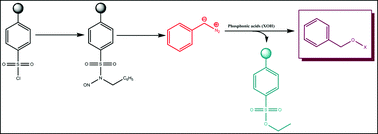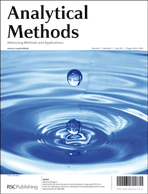We report herein the synthesis, characterization, stability study of a new solid supported derivatizing agent, N-benzyl-N-nitroso-4-poly(styrene-co-divinylbenzene)sulfonamide beads, for the preparation of phenyldiazomethane (PDM). The active component loading was found to be 2.0 ± 0.1 mmol g−1. This derivatizing agent is easy to synthesize and purify. The impurities and byproducts generated during the formation of PDM remain bound to the polymer backbone. These byproducts can be easily removed by filtration. Thus, pure PDM is obtained without the need for further purification. Due to the formation of a dilute solution of PDM, the chances of explosion and intoxication are minimized. The PDM from this derivatizing agent was used for the benzylation of a variety of acids. We have evaluated this derivatizing agent for the benzylation of alkylphosphonic acids (APAs) and alkyl alkylphosphonic acids (AAPAs). Subsequently, this reagent was applied for analysis of a real sample containing pinacolyl methylphosphonic acid by onflow LC-UV-1H NMR analysis.

You have access to this article
 Please wait while we load your content...
Something went wrong. Try again?
Please wait while we load your content...
Something went wrong. Try again?


 Please wait while we load your content...
Please wait while we load your content...